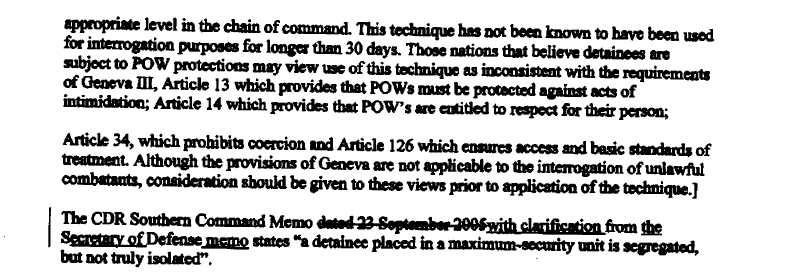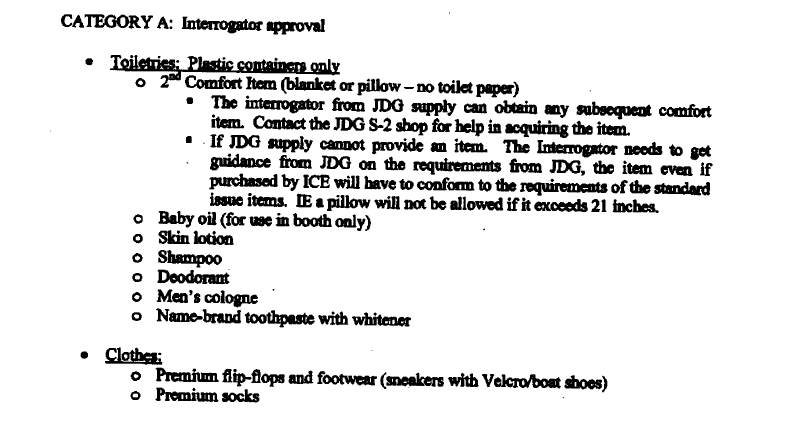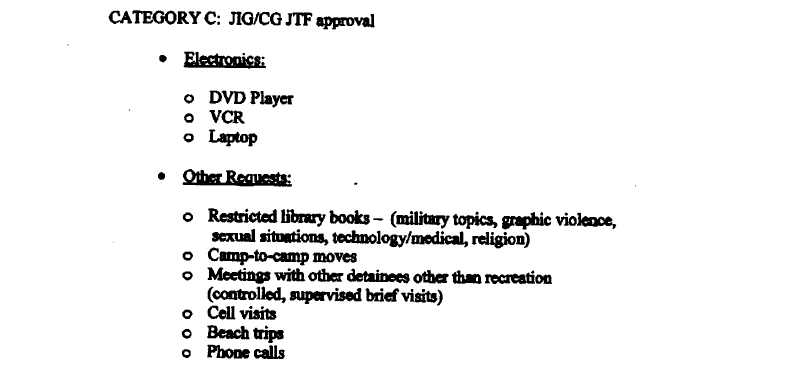In the wake of the June 2005 Schmidt-Furlow Report, an AR 15-6 investigation into FBI allegations of torture during interrogations at Guantanamo Bay, new Interrogation Control Element (ICE) Standard Operations Procedures were issued to the Joint Task Force - Guantanamo, the segment tasked with detention camp operation.
In response to a Freedom of Information Act request submitted by MuckRock user Jeffrey Kaye, the Office of the Secretary of Defense recently provided the revised SOP. Among extensively redacted pages, it describes the ICE chain of command, basic guidelines for use of incentives, and some of the “authorized approaches” that led to those allegations.


Nearly every page detailing procedures regarding the way to approach the interrogation — roughly ten — have been redacted under exemption b(1), 1.4a, as have the corresponding entries in the document’s table of contents.

The section begins, however, with an appeal to each interrogator to “use their own creativity and training in determining which approaches to use and how.” These approaches would require the interrogator to provide reasons for their implementation of particular techniques — “All decisions to use an approach should be from the least intrusive method.”

However, the segment wraps up with a specific note that a particular unidentified technique has “not been known to have been used for interrogation purposes for longer than 30 days.” That technique is isolation - solitary confinement - and the paragraph notes that some would view its use as being in violation of the Geneva Convention: “consideration should be given to these views prior to application of the technique.”

A considerable chunk of procedures concerns the use of incentives, which are broken down into basic amenities such as food and toiletries, which require no additional approval from a superior before being offered:


To highly desirable offerings like beach trips and access to restricted library material, which necessitate extensive vetting.

Interrogators are encouraged to keep track of frequent requests that are not on the pre-approved list, so that they can be added to the incentive rotation. The SOP uses the somewhat bizarre example of a picture of a horse to illustrate this:

One of the allegations referenced in the Schmidt-Furlow report was the use of feminine wiles in the performance of interrogations. This was an authorized approach meant to “highlight futility of the detainee’s situation.”


In the updated SOP, no clear explicit technique is authorized: interrogators who are “well aware of these attitudes” — i.e. prisoners’ attitudes toward gender, apparently — “may be able to use gender stereotypes to their advantage.”

The same goes for “Muslim sense of futility” and fatalism:


While the original scope of Kaye’s request was limited to the use of loud music and strobe lights, the OSD released both the SOP and the full Schmidt-Furlow report. The report does mention the use of so-called “futility music” - identified as “Metallica, Britney Spears, and Rap music” - and indicates no organizational response to the complaints.

Until the December 2014 release of the Senate Intelligence Committee report, the stories of the prisoners held until these conditions had been considered classified information. Read them all on the request page, or embedded below:
Image by Kathleen T. Rhem via Wikimedia Commons




